|
|
|
|
|
Oil On
Canvas, Real Flavor of Old Masters
|
|

|
ARTWORKS
INDEX
A B C D E F G H I J K L M N O P Q R S T U V W X Y Z |
ARTISTS
INDEX
A B C D E F G H I J K L M N O P Q R S T U V W X Y Z |
|
|
| | |
|
|
|
|
|
|
 |
Dwight William Tryon -- Click Here
|
|
(August 13, 1849 ?C July 1, 1925) was an American landscape painter in the late 19th and early 20th centuries. His work was influenced by James McNeill Whistler, and he is best-known for his landscapes and seascapes painted in a tonalist style.
Tryon was born in Hartford, Connecticut. His father was killed in a gun accident before Tryon reached four years of age, and Tryon was raised by his mother on his grandparent's farm in East Hartford. His interest in art evolved naturally. As a young man Tryon took a job at a prominent Hartford bookstore and studied art instruction manuals from the store shelves. He also took to sketching the surrounding countryside during his off hours
Tryon sold his first painting in 1870. After exhibiting and selling work locally, he successfully exhibited at the National Academy of Design in 1873. His artistic convictions affirmed, Tryon married, quit his job at the bookstore and became a full-time artist. Some of his first works from this period are seascapes and harbor views executed in a luminist manner. Soon after, however, Tryon's style shifted towards the Barbizon school, which was then becoming popular among American artists. He may have been influenced by the works of George Inness and Alexander Helwig Wyant.
In 1876 Tryon decided to advance his skills through a formal study of art. He sold all of his paintings at auction and, with the help of a benefactor, traveled to France with his wife. He enrolled in the atelier of Jacquesson de la Chevreuse, and took classes at the École des Beaux-Arts. He also received instruction from Charles-François Daubigny, Henri Harpignies, and Jean Baptiste-Antoine Guillemet. Impressionism was blossoming in France all around Tryon, but he was not swayed by the new style and remained comfortably within the realm of the Barbizon school.
Tryon traveled and sketched Europe with his wife, and met Abbott Handerson Thayer and his wife with whom he became friends. He returned to the United States in 1881 and settled in New York City where he taught and painted landscapes. In New York, Tryon became friends with artists Robert Swain Gifford and Thomas Dewing. He became an early member of the Society of American Artists and continued to exhibit paintings to the National Academy of Design. He also became a member of the American Water Color Society and the National Institute of Arts and Letters (now The American Academy of Arts and Letters).
On the advice of Gifford, Tryon and his wife built a summer house in South Dartmouth, Massachusetts in 1887. Though he would continue to spend each winter in New York City, South Dartmouth became Tryon's home for the rest of his life. The coastal area appealed to Tryon's aesthetic sensibilities and allowed him to indulge in fishing, his favorite pastime.
By the late 1880s Tryon began painting landscapes in what would become his mature and iconic style. Working most often in oil, Tryon's paintings typically feature a group or broken row of trees in the middle distance, often colored in an autumnal hue, separating a glowing sky above and a foreground marsh or pasture below. He also continued to paint the sea in his mature career, often employing pastel to show a bare expanse of water, sky and beach in various weather and light. He exhibited his works nationally but tended to favor The Pennsylvania Academy of Fine Arts in Philadelphia and the Montross Gallery in New York.
A Detroit industrialist, Charles Lang Freer, first bought a painting by Tryon in 1889 and became Tryon's most important patron. Freer eventually bought dozens of Tryon's paintings, including many of his best works, and worked closely with Tryon in the interior design of his Detroit home. Freer, a major collector of Asian art and works by James McNeill Whistler, went on to establish the Freer Gallery of Art, part of the Smithsonian Institution in Washington, DC, where many works by Tryon can be seen today.
Took the coveted First Prize for his painting Salt-Marsh, December at the Tennessee Centennial Exposition that was held in Nashville, Tennessee in 1897. He is described in the "Fine Art Catalogue" which is copyrighted by Theodore Cooley as follows: William Tryon is an American landscape painter whose pictures are greatly sought for their delicacy of coloring and refinement of feeling. A pupil of Daubdigny, he is, like that artist, a painter of country life - the idyllic rusticity of apple trees in bloom, of waving cornfields, of shining valleys and streams rippling gently to the sea. He is especially fine in the silvery-gray atmosphere.
In addition to his painting, Tryon taught at Smith College from 1886 to 1923, visiting part time to critique students' work and, late in his career, establishing the Tryon Gallery of Art. He died of cancer in South Dartmouth on July 1, 1925.
|
|
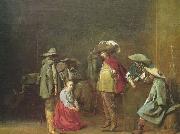 |
DUYSTER, Willem Cornelisz. -- Click Here
|
|
Dutch Baroque Era Painter, 1599-1678 |
|
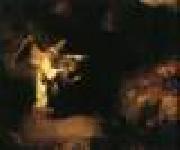 |
DROST, Willem -- Click Here
|
|
Dutch Baroque Era Painter, ca.1630-1680
Dutch painter, draughtsman and printmaker, possibly of German origin. According to Houbraken, he was a pupil of Rembrandt, possibly in or shortly before 1650. An early etching signed w drost 1652 is probably a self-portrait, in which Drost portrayed himself as a young man drawing. His earliest dated paintings are two pendants of 1653: the Portrait of a Man (New York, Met.) and the Portrait of a Woman (The Hague, Mus. Bredius). The man's portrait is signed Wilhelmus Drost F. Amsterdam 1653 |
|
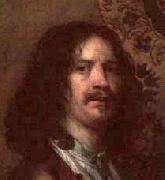 |
DOBSON, William -- Click Here
|
|
English Baroque Era Painter, ca.1611-1646
English painter. His father, William Dobson, was a gentleman of St Albans employed by Francis Bacon, Viscount Verulam, on the building and decoration at Verulam House and Gorhambury; he was also probably Master of the Alienation Office and a member of the Painter-Stainers' Company, but according to John Aubrey, 'he spending his estate luxuriously upon women, necessity forced his son William Dobson to be the most excellent painter |
|
|
|
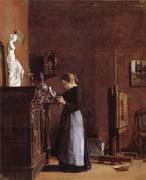 |
De Winter Pharaon -- Click Here
|
|
French realist painter , 1849-Little 1924
|
|
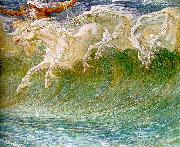 |
Crane, Walter -- Click Here
|
|
English Golden Age Illustrator, 1845-1915
English painter, illustrator, designer, writer and teacher. He showed artistic inclinations as a boy and was encouraged to draw by his father, the portrait painter and miniaturist Thomas Crane (1808-59). A series of illustrations to Tennyson's The Lady of Shalott (Cambridge, MA, Harvard U., Houghton Lib.) was shown first to Ruskin, who praised the use of colour, and then to the engraver William James Linton, to whom Crane was apprenticed in 1859. From 1859 to 1862 Crane learnt a technique of exact and economical draughtsmanship on woodblocks. |
|
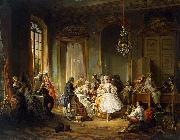 |
Constant Wauters -- Click Here
|
|
painted Actors Before a Performance in 1851 |
|
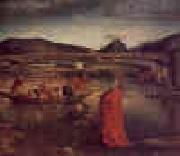 |
Conrad Witz -- Click Here
|
|
1400-1446 German
(Resident in Switzerland)
Conrad Witz Gallery
-6). German painter. One of the great innovators in northern European painting, he turned away from the lyricism of the preceding generation of German painters. His sturdy, monumental figures give a strong impression of their physical presence, gestures are dignified and the colours strong and simple. Even scenes with several figures are strangely undramatic and static. The surface appearance of materials, especially metals and stone, is intensely observed and recorded with an almost naive precision. Powerful cast shadows help to define the spatial relationships between objects. His fresh approach to the natural world reflects that of the Netherlandish painters: the Master of Fl?malle and the van Eycks. He need not, however, have trained in the Netherlands or in Burgundy as knowledge of their style could have been gained in Basle. He remained, however, untouched by the anecdotal quality present in their art, while Witz pure tempera technique differs emphatically from the refined use of oil glazes that endows Netherlandish pictures with their jewel-like brilliance. |
|
 |
Conrad Wise Chapman -- Click Here
|
|
1842-1910
Conrad Wise Chapman Gallery |
|
|
|
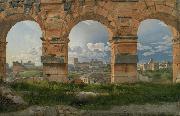 |
Christoffer Wilhelm Eckersberg -- Click Here
|
|
Danish Neoclassical Painter, 1783-1853
Danish painter and teacher. He has been called 'the father of Danish painting' because of the influence he exerted on Danish painters in the second quarter of the 19th century. With Christen K?bke he was the leading painter of the Danish 'Golden Age' (c. 1800-1850). |
|
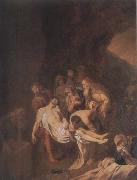 |
Christian Wilhelm Ernst Dietrich -- Click Here
|
|
German Painter, 1712-1774,German painter and etcher. He received his first training from his father, Johann Georg Dietrich (1684-1752), a court painter at Weimar, and was sent to Dresden at the age of 13 to study under the landscape painter Johann Alexander Thiele (1685-1752). In 1728 they travelled to Arnstadt to paint landscapes for stage sets. In 1730 Thiele presented his pupil to Frederick-Augustus I, Elector of Saxony, as a prodigy; Frederick-Augustus appointed him court painter and entrusted him to his minister Heinrich, Graf von Brehl, for whom he worked on some decorative paintings. From 1732 he used the name 'Dietricy' to sign his paintings. He travelled in Germany from 1734 and may have visited the Netherlands, the source of his artistic inspiration. He returned from his travels in 1741 and was appointed court painter to Frederick-Augustus II, Elector of Saxony, who sent him to Italy in 1743 to study. He visited Venice and Rome but returned to Dresden in 1744. |
|
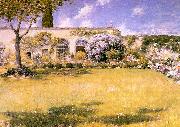 |
Chase, William Merritt -- Click Here
|
|
American Impressionist Painter, 1849-1916
American painter and printmaker. He received his early training in Indianapolis from the portrait painter Barton S. Hays (1826-75). In 1869 he went to New York to study at the National Academy of Design where he exhibited in 1871. That year he joined his family in St Louis, where John Mulvaney (1844-1906) encouraged him to study in Munich. With the support of several local patrons, enabling him to live abroad for the next six years, Chase entered the K?nigliche Akademie in Munich in 1872. Among his teachers were Alexander von Wagner (1838-1919), Karl Theodor von Piloty and Wilhelm von Diez (1839-1907). Chase also admired the work of Wilhelm Leibl. The school emphasized bravura brushwork, a technique that became integral to Chase's style, favoured a dark palette and encouraged the study of Old Master painters, particularly Diego Vel?zquez and Frans Hals. Among Chase's friends in Munich were the American artists Walter Shirlaw, J. Frank Currier and Frederick Dielman (1847-1935), |
|
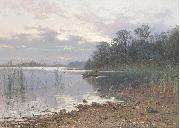 |
Charlotte Wahlstrom -- Click Here
|
|
painted Lake landscape at dusk in 1887 |
|
 |
Charles Wilson Peale -- Click Here
|
|
1741-1827
Charles Wilson Peale Galleries
Finding that he had a talent for painting, especially portraitures, Peale studied for a time under John Hesselius and John Singleton Copley. Friends eventually raised enough money for him to travel to England to take instruction from Benjamin West. Peale studied with West for two years beginning in 1767, afterward returning to America and settling in Annapolis, Maryland. There, he taught painting to his younger brother, James Peale, who in time also became a noted artist.
Peale's enthusiasm for the nascent national government brought him to the capital, Philadelphia, in 1776, where he painted portraits of American notables and visitors from overseas. His estate, which is on the campus of La Salle University in Philadelphia, can still be visited. He also raised troops for the War of Independence and eventually gained the rank of captain in the Pennsylvania militia by 1777, having participated in several battles. While in the field, he continued to paint, doing miniature portraits of various officers in the Continental Army. He produced enlarged versions of these in later years. He served in the Pennsylvania state assembly in 1779-1780, after which he returned to painting full-time.
Peale painted in the trompe l'oeil style,[1] and was quite prolific as an artist. While he did portraits of scores of historic figures (such as John Hancock, Thomas Jefferson and Alexander Hamilton), he is probably best known for his portraits of George Washington. The first time Washington ever sat for a portrait was with Peale in 1772, and there would be six other sittings; using these seven as models, Peale produced altogether close to 60 portraits of Washington. In January 2005, a full length portrait of "Washington at Princeton" from 1779 sold for $21.3 million dollars - setting a record for the highest price paid for an American portrait.
Peale had a great interest in natural history, and organized the first U.S. scientific expedition in 1801. These two major interests combined in his founding of what became the Philadelphia Museum, and was later renamed the Peale Museum.
This museum is considered the first. It housed a diverse collection of botanical, biological, and archaeological specimens. Most notably, the museum contained a large variety of birds which Peale himself acquired, and it was the first to display North American mammoth bones.
The display of the mammoth bones entered Peale into a long standing debate between Thomas Jefferson and Comte de Buffon. Buffon argued that Europe was superior to the Americas biologically, which was illustrated through the size of animals found there. Jefferson referenced the existence of these mammoths (which he believed still roamed northern regions of the continent) as evidence for a greater biodiversity in America. Peale's display of these bones drew attention from Europe, as did his method of re-assembling large skeletal specimens in three dimensions.
The museum was among the first to adopt Linnaean taxonomy. This system drew a stark contrast between Peale's museum and his competitors who presented their artifacts as mysterious oddities of the natural world.
The museum underwent several moves during its existence. At various times it was located in several prominent buildings including Independence Hall and the original home of the American Philosophical Association.
The museum would eventually fail in large part because Peale was unsuccessful at obtaining government funding. After his death, the museum was sold to, and split up by, showmen P. T. Barnum and Moses Kimball. |
|
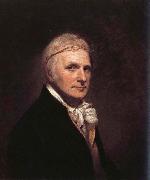 |
Charles Willson Peale -- Click Here
|
|
1741-1827
Painter and museum founder. After serving as a saddler's apprentice in Annapolis, MD, from 1754 to 1761, he worked at various trades, including painting signs and portraits. In 1766 some prominent Marylanders underwrote his studies in London with Benjamin West, from whom he absorbed the fundamentals of the British portrait tradition. Peale probably attended the informal life classes offered at St Martin's Lane Academy, precursor to the Royal Academy Schools, and drew from casts in the Duke of Richmond's collection in Whitehall. He visited the studios of such important British portrait painters as Joshua Reynolds, Francis Cotes and Allan Ramsay and studied the techniques of miniature painting, sculpture and engraving. In London he executed his first major commission |
|
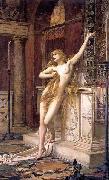 |
Charles William Mitchell -- Click Here
|
|
(1854 - 1903) was an English Pre-Raphaelite painter from Newcastle. A contemporary of John William Waterhouse, his work is similar in many ways. His one famous piece was Hypatia, shown in 1885 and likely inspired by the Charles Kingsley serialized novel Hypatia or New Foes with an Old Face. This painting is currently in the Laing Art Gallery. |
|
|
|
|
|
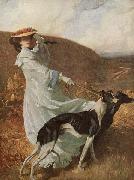 |
Charles Wellington Furse -- Click Here
|
|
(January 13, 1868 - October 16, 1904) was an English painter.
He was born at Staines, the son of the Rev. C. W. Furse, archdeacon of Westminster, and rector of St John's, Smith Square and descended collaterally from Sir Joshua Reynolds; and in his short span of life achieved such rare excellence as a portrait and figure painter that he forms an important link in the chain of British portraiture which extends from the time when Van Dyck was called to the court of Charles I into the 20th century.
His talent was precocious; at the age of seven he gave indications of it in a number of drawings illustrating Scott's novels. He entered the Slade School in 1884, winning the Slade scholarship in the following year, and completed his education at Julians Atelier in Paris. Hard worker as he was, his activity was frequently interrupted by spells of illness, for he had developed signs of consumption when he was still attending the Slade school. An important canvas called Cain was his first contribution (1888) to the Royal Academy, to the associateship of which he was elected in the year of his death. For some years before he had been a staunch supporter of the New English Art Club, to the exhibitions of which he was a regular contributor.
In October 1900 he married Katharine Symonds, the daughter of John Addington Symonds. She later became known as Dame Katharine Furse. The couple had 2 sons. His fondness for sport and of an open-air life found expression in his art and introduced a new, fresh and vigorous note into portraiture. There is never a suggestion of the studio or of the fatiguing pose in his portraits. The sitters appear unconscious of being painted, and are generally seen in the pursuit of their favourite outdoor sport or pastime, in the full enjoyment of life. Such are the Diana of the Uplands, the Lord Roberts and The Return from the Ride at the Tate Gallery; the four children in the Cubbing with the York and Ainsty, The Lilac Gown, Mr. and Mrs. Oliver Fishing and the portraits of Lord Charles Beresford and William Johnson Cory.
Most of these pictures, and indeed nearly all the work completed in the few years of Furse's activity, show a pronounced decorative tendency. His sense of space, composition and decorative design can best be judged by his admirable mural decorations for Liverpool town hall, executed between 1899 and 1902. A memorial exhibition of Furse's paintings and sketches was held at the Burlington Fine Arts Club in 1906.
|
|
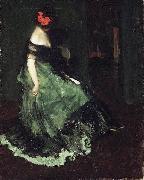 |
Charles Webster Hawthorne -- Click Here
|
|
(January 8, 1872 - November 29, 1930) was an American portrait and genre painter and a noted teacher who founded the Cape Cod School of Art in 1899.
He was born in Lodi, Illinois and his parents returned to Maine, raising him in the state where Charles' father was born. |
|
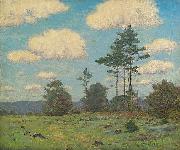 |
Charles Warren Eaton -- Click Here
|
|
painted The Stump Lot in 1857 - 1937 |
|
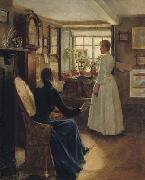 |
Charles W. Bartlett -- Click Here
|
|
(born 1 June 1860 in Bridport, Dorset) was an English painter and printmaker. He studied metallurgy and worked in that field for several years. At age 23, he enrolled in the Royal Academy in London, where he studied painting and etching. After three years of study in London, he entered the private studio school Academie Julian in Paris, where he studied under Jules Joseph Lefebvre (1836-1911) and Gustave Boulanger (1824-1888).
In 1889, he returned to England and married Emily Tate, but shortly thereafter, his wife and infant son died in childbirth. Bartlett then traveled to Europe, spending several productive years in Holland, Brittany and Venice with his friend and fellow artist Frank Brangwyn (1867-1956). Brangwyn is believed to have introduced Bartlett to Japanese prints. Bartlett produced some of his most important early works on the Continent, especially studies of peasants painted in broad areas of color. He was invited to join the Societe Nationale des Beaux-Arts in France in 1897. In 1898, he returned to England and married Catherine Kate Main. |
|
 |
Charles Lennox-Wright -- Click Here
|
|
painted Catching a dream in before 1932 |
|
 |
Charles Ferdinand Wimar -- Click Here
|
|
German-born American Painter
b.1828 d.1862
was a painter of Western Native Americans and buffaloes. Born in Siegenburg, Germany, came to America at the age of 15, settled with his parents in St. Louis, Missouri. In 1846 he began studying painting with Leon Pomarede and went with his master on a trip up the Mississippi River. In 1852 he went to the D??sseldorf Academy to study with Emanuel Leutze. Wimar returned to St. Louis in 1856. He primarily occupied himself with the themes of Indian life, buffalo herds, life in the Great Plains, the theme of the wagon trains. He made three trips to the headwaters of the Mississippi. |
|
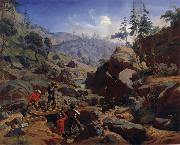 |
Charles Christian Nahl and august wenderoth -- Click Here
|
|
German-born American Painter, 1818-1878
American, 1819-1884 |
|
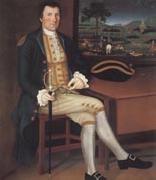 |
Chandler Winthrop -- Click Here
|
|
American Colonial Era Painter, 1747-1790
American painter. He was one of ten children of William Chandler, a farmer, and Jemima Bradbury Chandler of Woodstock, CT. After the death of his father in 1754 and on reaching the age for apprenticeship, Chandler pursued a career as a portrait and ornamental painter. While there is no proof of his presence in Boston, the History of Woodstock (1862) states that he studied portrait painting there. He may also have had the opportunity to view works by the major artist of the city, John Singleton Copley, as well as those of his lesser-known contemporaries, William L. Johnston and Joseph Badger. In the course of his career, Chandler worked in such diverse trades as gilding, carving and illustrating, as well as portraiture, landscape and house painting, suggesting that he received some instruction as an artisan-painter. |
|
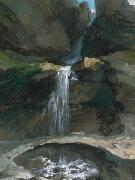 |
Caspar Wolf -- Click Here
|
|
Caspar Wolf (Muri, Aargau, 3 May 1735 - Heidelberg, 6 October 1783) was a Swiss painter, known mostly for his dramatic paintings of Alps. He was strongly influenced by Albrecht von Hallers poem on the Alps, and the Sturm und Drang movement. After 1773 Wolf mostly painted glaciers, caves, waterfalls and gorges.
Wolf was the son of a furniture maker, who was banned from his city. Wolf was trained in Konstanz, between 1753 and 1759 he worked in Augsburg, Munich, Passau as a decoration painter. Not being able to sell his work he went disappointed back to his home town. For Horben Castle he painted by hand the wallpaper on the first floor. In 1768 Wolf lived in Basel. From 1769 till 1771 he stayed in Paris and worked with Philip James de Loutherbourg. In 1774 he moved to Bern. Wolf made a deal with the local publisher Abraham Wagner who had a geological interest, to deliver 200 paintings. He travelled with Wagner or a minister Jakob Samuel Wyttenbach in Berner Oberland and Wallis. From 1780-1781 he was working in Spa, Cologne, Aix-la-Chapelle and Desseldorf. He died in poor circumstances in a hospital.
In 1779 his prints were exposed were Bern but the selling of the book became a failure. Wagner became help from a Swiss army officer in Dutch service and in 1785 30 aquatints were published in Amsterdam. Till 1948 90 of these aquatints were exposed in Keukenhof Castle, but sold. Today these works can be seen in the Kunsthaus in Aarau.
His son Theodor Wolf (1770 - 1818) was a still life painter. |
|
 |
Caspar van Wittel -- Click Here
|
|
(born Caspar Adriaensz. van Wittel, later a.k.a. Gaspare Vanvitelli, Gasparo degli Occhiali) (1653 - September 13, 1736) was a Dutch Golden Age landscape painter.
Van Wittel was born in Amersfoort. He learned painting first from Thomas Jansz van Veenendaal for 4 or 5 years and then from Matthias Withoos for 7 years, until Withoos left Amersfoort. In Amersfoort, he likely was exposed to Dutch landscape artists such as Jan van der Heyden and Gerrit Berckheyde. His first extant works were made in Hoorn in 1672, but he relocated to Rome with his family ca. 1675 and made his career there. Like his former teacher, he joined the Bentvueghels with the nickname "Piktoors" or "Toorts van Amersfoort"(torch of Amersfort).
He married in Rome in 1697, and stayed most of his life in that city, though, between 1694 and 1710, he toured Italy and painted in places like Florence, Bologna, Ferrara, Venice, Milan, Piacenza and Naples. He is one of the principal painters of topographical views known as vedute.
Gaspar van Wittel died in Rome. His son Luigi would become a famous architect and also carries the italianized family name of Vanvitelli.
In Luigi's biography is written that his father was born in July 1656, but Van Wittel's grave in Rome states that he died at the age of 83 in 1736.
|
|
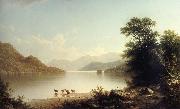 |
Casilear John William -- Click Here
|
|
American Hudson River School Painter, 1811-1893
was an American landscape artist belonging to the Hudson River School. Casilear was born in New York City. His first professional training was under prominent New York engraver Peter Maverick in the 1820s, then with Asher Durand, himself an engraver at the time. Casilear and Durand became friends, and both worked as engravers in New York through the 1830s. By the middle 1830s Durand had become interested in landscape painting through his friendship with Thomas Cole. Durand, in turn, drew Casilear's attention to painting. By 1840 Casilear's interest in art was sufficiently strong to accompany Durand, John Frederick Kensett, and artist Thomas P. Rossiter on a European trip during which they sketched scenes, visited art museums, and fostered their interest in painting. Casilear gradually developed his talent in landscape art, painting in the style that was later to become known as the Hudson River School. By the middle 1850s he had entirely ceased his engraving career in favor of painting full-time. He was elected a full member of the National Academy of Design in 1851, having been an associate member since 1831 |
|
|
|
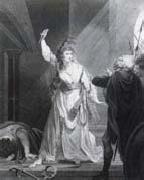 |
Caroline Watson -- Click Here
|
|
British 1760-1814,Daughter of James Watson. In 1780 she signed a stipple print of Isaac Watts and was soon employed by John Boydell (e.g. Prince William of Gloucester, 1784, after Joshua Reynolds). In 1785 she became Engraver to Queen Charlotte (1744-1818), a keen print collector. She was particularly fitted to working after miniatures, such was the delicacy of her engraving, and some of her best prints are portraits and small subjects after Samuel Shelley (c. 1750-1808). She did private commissions of this kind, notably for the Bute family, and also engraved large plates, some for the Boydell Shakespeare Gallery, including the Death of Cardinal Beaufort (1792) after Reynolds, allegedly at his request. She was employed by William Hayley (1745-1820) on his Life of George Romney Esq (London, 1809), and the correspondence involved shows her as a reliable and respected professional. |
|
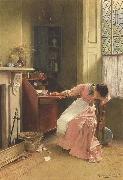 |
Carlton Alfred Smith,RI,RWS -- Click Here
|
|
fl.1871-1916
|
|
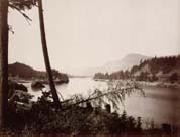 |
Carleton E.Watkins -- Click Here
|
|
American photographers , b. 1829, d. 1916
was a noted 19th century California photographer. Carleton Emmons Watkins was born in Oneonta, upstate New York. He went to San Francisco during the gold rush, arriving in 1851. He traveled to California with Oneontan Collis Huntington, who later became one of the owners of the Central Pacific Railroad, which helped Watkins later in his career. His interest in photography started as an aide in a San Francisco portrait studio, and started taking photographs of his own in 1861. He became interested in landscape photography and soon started making photographs of California mining scenes and of Yosemite Valley. He experimented with several new photographic techniques, and eventually favored his "Mammoth Camera," which used large glass plate negatives, and a stereographic camera. He became famous for his series of photographs and historic stereoviews of Yosemite Valley in the 1860s, and also created a variety images of California and Oregon in the 1870s and later. Watkins purchased the 1860s Central Pacific Railroad construction stereoview negatives from CPRR official photographer Alfred A. Hart and continued their publication through the 1870s. However Watkins was not a good businessman. He spent lavishly on his San Francisco studio and went deeply in debt. His photographs were auctioned, following a business setback, resulting in his photographs being published without credit by I. W. Taber, the new owner. Watkins also had problems of his photographs being reprinted without permission by Eastern companies and with other photographers rephotographing the exact scenes Watkins photographed. In 1879, Watkins married his 22-year-old assistant, Frances Sneade, with whom he had two children. Watkins began anew with his "New Series," which included a variety of subjects and formats, mostly related to California. |
|
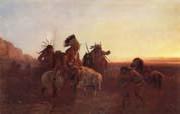 |
Carl Wimar -- Click Here
|
|
1828 - 1862,American painter and photographer of German birth. He arrived in St Louis in 1843. From 1846 to 1850 he studied painting under the St Louis artist Leon de Pomarede (1807-92). In 1852 he continued his studies at the Kunstakademie in Desseldorf, where he worked with Josef Fay (1813-75) and Emanuel Gottlieb Leutze until about 1856. In 1858, having once more based himself in St Louis, he travelled up the Mississippi in order to draw and photograph Indians. Wimar joined a party of the American Fur Trading Company and made several journeys between 1858 and 1860 up the Mississippi, Missouri and Yellowstone rivers in search of Indian subjects. His painting, the Buffalo Hunt (1860; St Louis, MO, Washington U., Gal. A.), became one of the original works in the collection of the Western Academy of Art. In 1861 Wimar was commissioned to decorate the rotunda of the St Louis Court-house with scenes of the settlement of the West. |
|
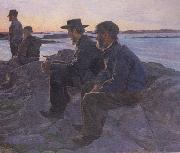 |
Carl Wilhelmson -- Click Here
|
|
1866-1928
Swedish painter and lithographer. Wilhelmson trained first as a commercial lithographer in Göteborg. In 1886 he enrolled as a student of decorative painting at Valand College of Art where his teacher was Carl (Olof) Larsson. In 1888, having obtained a travel grant, he went to Leipzig to study lithographic technique. From 1890 to 1896 he lived in Paris, where he worked as a lithographer and commercial artist and studied at the Academie Julian. Wilhelmson's preferred subject-matter was the coastal landscape of Bohuslen and the people of its little fishing villages with their huddles of wooden houses. There is no trace of ethnography in his depictions of local life; they are full of serious realism and display a sensitive insight into the perilous life of the fishermen, with which he had been familiar since childhood. In the Village Shop |
|
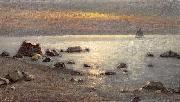 |
Carl Wilhelm Barth -- Click Here
|
|
(1847 - 1919) was a Norwegian painter.
He was born in Christiania. He studied painting under Hans Gude from 1881 to 1883, and having worked as a naval officer until then, he specialized in marine art. He is represented with three works in the National Gallery of Norway.
He was the son of Jacob Bøckmann Barth and brother of Agnar Johannes Barth, both foresters.
|
|
|
|
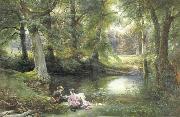 |
Carl Friedrich WilhelmTrautschold -- Click Here
|
|
1815-1877
|
|
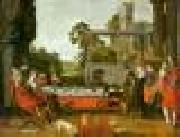 |
BUYTEWECH, Willem -- Click Here
|
|
Dutch Baroque Era Painter, ca.1591-1624
Dutch painter, draughtsman and etcher. Although he was born and died in Rotterdam, stylistically he belongs to the generation of young artists working in Haarlem at the beginning of the 17th century. He was nicknamed 'Geestige Willem' (Dut.: 'inventive, or witty, Willem') by his contemporaries, and during his short career he made an important and highly personal contribution to the new approach to realism in Dutch art. He was one of the first to paint interiors with merry companies
|
|
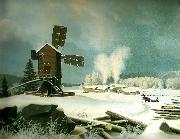 |
broderna von wrights -- Click Here
|
|
Dessa ornitologer, forskare, naturvetenskapliga illustratörer och konstnärer var födda i Haminanlaks nära Kuopio i Finland.
I Stockholm i augusti 1828 påbörjade Magnus och Wilhelm von Wright bildverket Svenska Foglar, finansierat av greve Nils Bonde. Detta ornitologiska verk blev klart 1838 och ar en en samling pa178 litografier.
|
|
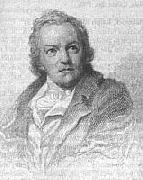 |
Blake, William -- Click Here
|
|
William Blake was an English poet, painter was born November 28, 1757, in London
William Blake started writing poems as a boy, many of them inspired by religious visions. Apprenticed to an engraver as a young man, Blake learned skills that allowed him to put his poems and drawings together on etchings, and he began to publish his own work. Throughout his life he survived on small commissions, never gaining much attention from the London art world. His paintings were rejected by the public |
|
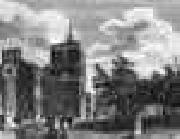 |
Birch, William Russell -- Click Here
|
|
American, 1755-1834 |
|
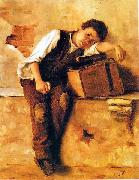 |
Bertha Worms -- Click Here
|
|
painted Missing Naples in 1895 |
|
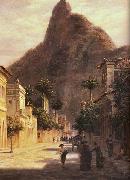 |
Bernhard Wiegandt -- Click Here
|
|
painted Sao Clemente Street, Rio de Janeiro in 1884 |
|
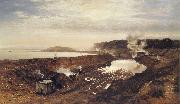 |
Benjamin Williams Leader -- Click Here
|
|
British Painter, 1831-1923
was an English artist. Born in Worcester as Benjamin Leader Williams, he was the son of civil engineer Edward Leader Williams (who was also a keen amateur artist and friend of John Constable) and Quaker Sarah Whiting. His brother, also called Edward Leader Williams, followed in his father's footsteps and became a notable civil engineer. The family lived in Worcester at Diglis House. Williams Leader was educated at the Royal Grammar School Worcester and then the Royal Academy Schools. He immediately became successful as an artist and first exhibited his work at the Royal Academy in 1854. Since that year until his death in 1923 his paintings were hung in every summer exhibition at the Royal Academy. He was knighted as Chevalier of the Legion of Honour by the French in 1889 and was created a full member of the Royal Academy in 1898 (RA - Royal Academician). In 1914 he was given the Freedom of the City of Worcester in recognition of his services (as a director of Royal Worcester Porcerlain and a native of the city). Famous paintings include February Fill Dyke and Autumn's Last Gleam. His paintings were bought by King George V and William Gladstone amongst others, and he became one of the most popular and expensive artists of his day. His works received popular approval for their verisimilitude, and the fame of February Fill Dyke, facilitated by an etching, spread to London, Paris, and the United States. |
|
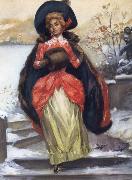 |
Benjamin West Clinedinst -- Click Here
|
|
Illustrator and Painter.
American , 1859-1931
was an American illustrator and painter, born at Woodstock, Va. He studied for a year in Baltimore and for five years in Paris under Cabanel and Bonnat and first attracted attention in New York with his illustrations for Leslie's Weekly. He was best known as the illustrator of Thomas Nelson Page's Unc' Edinburg, the works of Hawthorne, Stevenson, and Mark Twain, although he worked also in oils and water colors. His sympathetic collaboration with the author gave his work an especial charm. He was awarded the Evans prize of the American Water-Color Society in 1900. In 1947. |
|
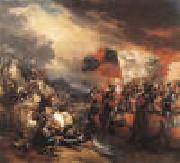 |
Benjamin West -- Click Here
|
|
1738-1820
Benjamin West Locations
Benjamin West RA (October 10, 1738 ?C March 11, 1820) was an Anglo-American painter of historical scenes around and after the time of the American War of Independence. He was the second president of the Royal Academy serving from 1792 to 1805 and 1806 to 1820.
In 1760, sponsored by Smith and William Allen, reputed to be the wealthiest man in Philadelphia, West traveled to Italy where he expanded his repertoire by copying the works of Italian painters such as Titian and Raphael.
As painted by Gilbert Stuart, 1783-84West was a close friend of Benjamin Franklin, whose portrait he painted. Franklin was also the godfather of West's second son, Benjamin.
In 1763, West moved to England, where he was commissioned by King George III to create portraits of members of the royal family. The king himself was twice painted by him. He painted his most famous, and possibly most influential painting, The Death of General Wolfe, in 1770, exhibited at the Royal Academy in 1771. Although originally snubbed by Sir Joshua Reynolds, the famous portrait painter and President of the Royal Academy, and others as over ambitious, the painting became one of the most frequently reproduced images of the period.
In 1772, King George appointed him historical painter to the court at an annual fee of £1,000. With Reynolds, West founded the Royal Academy of Arts in 1768. He was the second president of the Royal Academy from 1792 to 1805. He was re-elected in 1806 and was president until his death in 1820. He was Surveyor of the King's Pictures from 1791 until his death. Many American artists studied under him in London, including Charles Willson Peale, Rembrandt Peale, Gilbert Stuart, John Trumbull, and Thomas Sully. [3]
West is known for his large scale history paintings, which use expressive figures, colours and compositional schemes to help the spectator to identify with the scene represented. West called this "epic representation".
He died in London. |
|
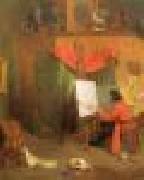 |
Beard, William Holbrook -- Click Here
|
|
American Painter, 1824-1900 |
|
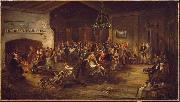 |
Attributed to Wilkie -- Click Here
|
|
painted The Christmas Party 1850 |
|
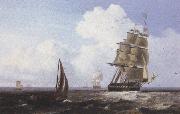 |
Attributed to john wilson carmichael -- Click Here
|
|
1800-1868
|
|
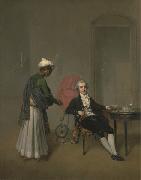 |
Arthur William Devis -- Click Here
|
|
(10 August 1762 - 11 February 1822) was an English painter of history paintings and portraits. He was appointed draughtsman in a voyage projected by the East India Company in 1783, under Captain Henry Wilson, in which he was wrecked on the Pelew Islands before proceeding to Canton and thence to Bengal. He painted portraits and historical subjects, sixty-five of which he exhibited (1779-1821) at the Royal Academy.
|
|
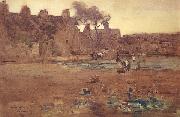 |
Arthur Melville,ARSA,RSW,RWS -- Click Here
|
|
1855-1904 |
|
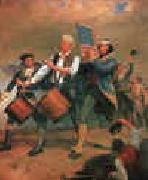 |
Archibald M Willard -- Click Here
|
|
1836-1918
Archibald M Willard Gallery |
|
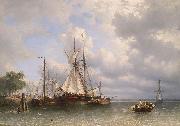 |
Antonie Waldorp -- Click Here
|
|
(The Hague, 28 March, 1803 - Amsterdam, 12 October, 1866) was a Dutch painter and a forerunner of the Hague School.
Anthonie Waldorp was the son of Abel de Saaijer Waldorp and Jacomina Godde, and the grandson of Jan Gerard Waldor, who was superintendent of the National Art Gallery. On February 25, 1824 he married Johanna Sophia Waldorp van Hove. At the wedding in The Hague there was a clerical error in the marital attachments, mistakenly registering Anthonie as Anthonie Waldorp instead of Saaijer Waldorp.
Shortly after his 23rd birthday, Anthonie decides to follow a career as a painter and became one of the precursors of the Hague School. Anthonie took an apprenticeship with the well known stage scenery painter Joannes Breckenheimer jr. (1772-1856) in The Hague, who was also the tutor of the well known painter Andreas Schelfhout.
Anthonie started painting stage sceneries like his grandfather. Later he focused on domestic and church interiors and portraits (people in 17th century costumes). Finally he specialized in landscapes, river and seascapes (paintings, drawings and water colors). It proved to be a wise decision as it led to international recognition. He also did some lithographic work. In 1833, together with Wijnand Nuyen, he traveled through France, Belgium and Germany and became the tutor of C.P. et Hoen, J.C. Hofman, C. Rochussen and Johan Hendrik Weissenbruch. Many of his paintings were bought by German, Dutch and French kings.
Until 1857 he lived in The Hague, after which he settled in Amsterdam where he joined the Royal Academy . He received several awards: in 1845 Waldorp was appointed Knight of the Order of Leopold by the Belgian king, Knight in the Order of the Dutch Lion in 1847 by King William II and Knight in the Order of the Oak Crown in 1849 by William.
In The Hague and Amsterdam there are streets named after Anthonie Waldorp.
|
|
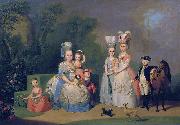 |
Anton Wilhelm Tischbein -- Click Here
|
|
(1730 -1804 ) - Painter
|
|
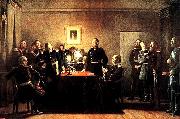 |
Anton von Werner -- Click Here
|
|
Germany (1843- 1915 ) - Painter |
|
|
|
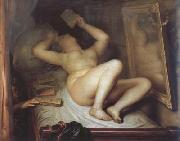 |
Antoine Wiertz -- Click Here
|
|
Belgian Painter, 1806-1865
Belgian painter and sculptor. He was from very humble origins, but his talent for drawing was detected at an early age. He was sent to the Antwerp Academie, where he attended classes given by W. J. Herreyns (1743-1827) and Mathieu Ignace Van Br?e. During a stay in Paris from 1829 to 1832 he came into contact with the Romantic painters, in particular Th?odore G?ricault, who fostered his admiration for Rubens. In 1832 he won the Belgian Prix de Rome and in 1834 left for Italy where the works of Raphael and, above all, Michelangelo made an overwhelming impression on him. In Rome he abandoned the landscapes and scenes from Roman life, for which he showed a certain talent, and embarked on a much more ambitious work, the Greeks and the Trojans Contesting the Body of Patroclus (1835; Brussels, Mus. Wiertz.). The painting proved the turning-point in Wiertz's career. Its frenzied composition and violently contorted figures excited considerable interest in Rome. |
|
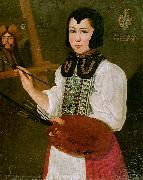 |
Anna Waser -- Click Here
|
|
Anna Waser (1678 - 1714) was a Swiss painter . |
|
 |
Andrew W. Warren -- Click Here
|
|
American undate-1873 |
|
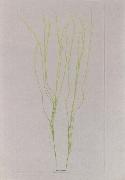 |
Alois Auer von Welsbach -- Click Here
|
|
Wels1813-1869 Vienna |
|
|
|
|
|
 |
Alfred Wallis -- Click Here
|
|
British
1855-1942
1942). English painter, fisherman and scrap merchant. Although the exact date of Wallis birth is doubtful, he stated in letters to Jim Ede, one of his greatest patrons, that he was born on the day of the fall of Sebastopol. He claimed to have gone to sea at the age of nine and was involved in deep-sea fishing, sometimes sailing as far as Newfoundland. About 1875 he married Susan Ward, a woman 21 years his senior, and shortly afterwards gave up deep-sea fishing to become an inshore fisherman. In 1890 he moved to St Ives, Cornwall, where he set up as a marine scrap merchant. In 1912 he retired. His wife died in 1922, whereupon he took up painting to keep himself company, as he told Ede. |
|
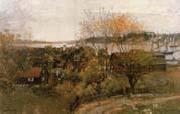 |
Alfred Wahlberg -- Click Here
|
|
1834-1906,Swedish painter. He received some tuition in drawing at the Royal Academy of Arts in Stockholm, although he was never formally enrolled as a student. In 1857 he went to D?sseldorf where he was a student of Hans Fredrik Gude. Swedish Landscape, Kolm?rden (1866; Stockholm, Nmus.) is representative of Wahlberg's D?sseldorf period. After a journey to the Netherlands and Belgium he returned to Stockholm in 1862 and became a member of the circle of artists around Karl XV. |
|
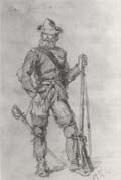 |
Alfred R. Waud -- Click Here
|
|
American, 1828-1891,was an American artist and illustrator, born in London, England. He is most notable for the sketches he made as an artist correspondent during the American Civil War. Before emigration, Alfred Waud had entered the Government School of Design at Somerset House, London, with the intention of becoming a marine painter. This did not come to fruition, but as a student, he also worked as a painter of theatrical scenery. He intended to pursue that work in the United States, when he immigrated in 1850, seeking employment with actor and playwright John Brougham. In the 1850s, he worked variously as an illustrator for a Boston periodical, the Carpet-Bag, and provided illustrations for books such as Hunter's Panoramic Guide from Niagara to Quebec (1857). The period during the American Civil War was time when all images in a publication had to be hand drawn and engraved by skilled artist. Photography existed but there was no way to transfer a photograph to a printing plate since this was well before the advent of the halftone process for printing photographs. Photographic equipment was too cumbersome and exposure times were to slow to be used on the battlefield. An artist such as Waud would do detailed sketches in the field, which were then rushed by courier back to the main office of the newspaper they were working for. There a staff of engravers would use the to sketches create finished engravings for publication. In 1860 Alfred Waud became an illustrator or special artist (a full time paid staff artist) for the New York Illustrated News. In April 1861, the newspaper assigned Waud to cover the Army of the Potomac, Virginia main Union army. He first illustrated General Winfield Scott in Washington, D.C., and then entered the field to render the First Battle of Bull Run in July. Waud followed a Union expedition to Cape Hatteras, North Carolina the next month. That autumn, he sketched army activity in the Tidewater region of Virginia. Waud joined Harper's Weekly toward the end of 1861, continuing to cover the war. In 1864 Alfred brother, William Waud (who up to that time had been working with Frank Leslie Illustrated Newspaper), joined Alfred on the staff of Harper's and they worked together during the Petersburg Campaign. Alfred Waud attended every battle of the Army of the Potomac between the First Battle of Bull Run in 1861 and the Siege of Petersburg in 1865. Alfred was one of only two artists present at the Battle of Gettysburg. His depiction of Pickett Charge is thought to be the only visual account by an eyewitness. Waud died in 1891 in Marietta, Georgia, while touring battlefields of the South. |
|
 |
Alf Wallander -- Click Here
|
|
painted Artillerigatan in Winter Dress in 1892 |
|
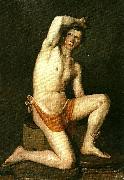 |
alexis wetterbergh -- Click Here
|
|
wetterberghs malning bar professor sandbergs godkannande paskrift, men eftersom maleri inte forekom pa konstakademiens schema fore 1856 |
|
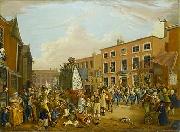 |
Alexander Wilson -- Click Here
|
|
Alexander Wilson (July 6, 1766 - August 23, 1813) was a Scottish-American poet, ornithologist, naturalist, and illustrator.
Wilson was born in Paisley, Scotland, the son of an illiterate distiller. In 1779 he was apprenticed as a weaver. His main interest at this time was in writing poetry (Robert Burns was seven years older than Wilson). Some of Wilson's work - commenting on the unfair treatment of the weavers by their employers - got him into trouble with the authorities. The "golden age of Renfrewshire song" is embodied in the persons of Wilson and Robert Tannahill. Alexander Wilson was born near the Hammils, a broad if not steep waterfall in Paisley where the River Cart skirts Seedhill. It does indeed appear to be the case, as William Motherwell states, that a great amount of literary activity began in Paisley around this time.
Illustration from
"An American ornithologyIn May 1794 Wilson left Scotland with his nephew to find a better life in America. Wilson obtained employment as a schoolteacher in Milestown, near Philadelphia. In 1801 he left Milestown and found a new teaching post in Gray's Ferry, Pennsylvania; Wilson took up residence in nearby Kingsessing. It was here that he met the famous naturalist William Bartram who developed Wilson's interest in ornithology. In 1802 Wilson decided to publish a book illustrating all the North American birds. With this in mind he traveled widely, watching and painting birds and collecting subscribers for his book. The result was the nine-volume American Ornithology (1808-1814), illustrating 268 species of birds, 26 of which had not previously been described. He died during the writing of the ninth volume, which was completed and published after his death by his friend George Ord. Wilson lies buried next to Ord at Gloria Dei Church cemetery in Philadelphia, Pennsylvania. |
|
|
|
 |
Alexander von Wagner -- Click Here
|
|
German/Hungarian, 1838-1919 |
|
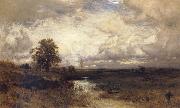 |
Alexander Helwig Wyant -- Click Here
|
|
American Tonalist Painter, 1836-1892,American painter. He began as an itinerant painter of topographical landscapes along the banks of the Ohio River c. 1854, influenced by such landscape artists as Worthington Whittredge and George Inness. In 1863-4 Wyant moved to New York, where he was impressed by the paintings of the Norwegian artist Hans Gude in the Desseldorf Gallery. This led him to work with Gude in Karlsruhe, Germany, in 1865. On his way both there and back, he studied paintings by Constable and used a more painterly technique especially for views of Ireland. |
|
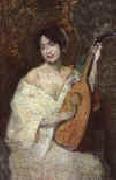 |
Alden J Weir -- Click Here
|
|
1852-1919
Painter, printmaker and teacher, son of (1) Robert Walter Weir. His art education began in the studio of his father. There he and his half-brother (2) John Ferguson Weir acquired an appreciation for the Old Masters, particularly of the Italian Renaissance and of the 17th-century Dutch schools. While Weir pursued in his art a course very different from that of his father and half-brother, his personality as well as his artistic attitudes were shaped by them. In the winters of 1870-71 and 1871-2, he continued his studies at the National Academy of Design in New York, where his instructor was Lemuel Wilmarth (1835-1918).
|
|
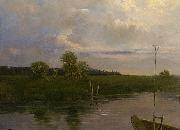 |
Albert Wohlenberg -- Click Here
|
|
painted Am Lehnitzsee bei Neu-Fahrland in 1899 |
|
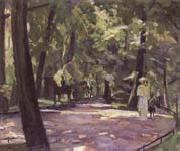 |
Albert Weisgerber -- Click Here
|
|
German, 1878-1915
German painter and printmaker. He studied decoration at the Kreisbaugewerksschule in Kaiserlautern (1891-3) and began work in a decorator studio in Frankfurt am Main. However, in 1894 he moved to Munich to resume his studies, first at the Kunstgewerbeschule and later under Franz von Stuck at the Akademie der Bildenden Kenste (1897-1901). For some years he concentrated on poster design and book illustration, contributing a total of 500 drawings to Jungend: Illustrierte Wochenschrift for Kunst und Leben from 1899. His early paintings such as the portrait of Ludwig Scharf II (c. 1905; Munich, Staatsgal. Mod. Kst) were executed in dark-toned academic style, but an exhibition of French Impressionism in Berlin in 1905 so impressed him that he went to Paris for nearly a year (until May 1906). Despite his association with the circle of artists around Matisse, he was more influenced by the work of Cezanne. In 1907 he made a second visit to Paris and joined Phalanx in 1909. In the latter year he was visited by Hans Purrmann and Matisse. By 1911 with a third visit to Paris and travels to Rome and Naples, he had established himself as one of the foremost German Impressionists. As well as such lyrical scenes as Munich Hofgarten (1911; Munich, Lenbachhaus), in common with many of his German contemporaries, Weisgerber reconceived classical scenes in an energetic style, for example in Amazon Camp (1910; Stuttgart, Staatsgal.). In 1912 he had a one-man show in the Kunsthaus, Zurich, and a year later participated in the annual Kunstausstellung in Munich. Although using an Impressionist style, he was equally at home in Expressionist circles, and this undoubtedly influenced his election to the presidency of the Neuen Menchner Sezession (1913). In the last four years of his career he was obsessed with sacrificial subject-matter from the Old and New Testaments, which he had originated in the theme of St Sebastian (e.g. St Sebastian Felled by Arrows, 1910; Munich, Staatsgal. Mod. Kst). While not exclusively tragic (e.g. David and Goliath, 1914; Saarbrecken, Saarland-Mus.), these final works strip away historical references to concentrate upon the fate of the isolated individual, as in Absalom (1914; Hamburg, Ksthalle). |
|
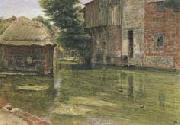 |
Albert Goodwin,RWS -- Click Here
|
|
1845-1932
English painter. During the early 1860s Goodwin studied with Arthur Hughes and Ford Madox Brown, who predicted that his pupil would become 'one of the greatest landscape painters of the age'. Hughes and Brown impressed on Goodwin the Pre-Raphaelite principles of high finish, vivid colour and working directly from nature that inform his early landscape style |
|
|
|
|
| | |
|
|
|
|